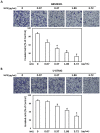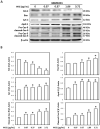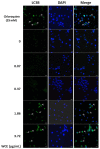Differential Effects of Wedelia chinensis on Human Glioblastoma Multiforme Cells
- PMID: 33729002
- PMCID: PMC7983241
- DOI: 10.1177/15347354211000119
Differential Effects of Wedelia chinensis on Human Glioblastoma Multiforme Cells
Erratum in
-
Corrigendum to Differential Effects of Wedelia chinensis on Human Glioblastoma Multiforme Cellls.Integr Cancer Ther. 2025 Jan-Dec;24:15347354251352682. doi: 10.1177/15347354251352682. Epub 2025 Jun 26. Integr Cancer Ther. 2025. PMID: 40567233 Free PMC article. No abstract available.
Abstract
Introduction: Glioblastoma multiforme (GBM) is the most aggressive glioma, and its diffuse nature makes resection of it difficult. Moreover, even with the administration of postoperative radiotherapy and chemotherapy, prolonged remission is often not achieved. Hence, innovative or alternative treatments for GBM are urgently required. Traditional Chinese herbs and their functional components have long been used in the treatment of various cancers, including GBM. The current study investigated the antitumor activity of Wedelia chinensis and its major functional components, luteolin and apigenin, on GBM.
Materials and methods: MTT assay, Transwell migration assay, and flow cytometry analysis were adopted to assess the cell viability, invasive capability, and cell cycle. Immunofluorescence staining and Western blotting were used to detect the expressions of apoptotic and autophagy-related signaling molecules.
Results: The W. chinensis extract (WCE) significantly inhibited the proliferation and invasive ability of both GBM8401 and U-87MG cells in a dose-dependent manner. Moreover, differential effects of WCE on GBM8401 and U-87MG cells were observed: WCE induced apoptosis in GBM8401 cells and autophagy in U-87MG cells. Notably, WCE had significant effects in reducing the cell survival and invasive capability of both GBM8401 and U-87MG cells than the combination of luteolin and apigenin.
Conclusions: Taken together, these findings indicate the potential of using WCE and the combination of luteolin and apigenin for GBM treatment. However, further investigations are warranted before considering recommending the clinical use of WCE or the combination of luteolin and apigenin as the standard for GBM treatment.
Keywords: Wedelia chinensis extract; apoptosis; autophagy; glioblastoma multiforme; traditional Chinese medicine.
Conflict of interest statement
Figures









Similar articles
-
The antiproliferative and apoptotic effects of apigenin on glioblastoma cells.J Pharm Pharmacol. 2017 Jul;69(7):907-916. doi: 10.1111/jphp.12718. Epub 2017 Mar 28. J Pharm Pharmacol. 2017. Retraction in: J Pharm Pharmacol. 2025 Sep 4;77(9):1292. doi: 10.1093/jpp/rgaf049. PMID: 28349530 Retracted.
-
Treatment options for progression or recurrence of glioblastoma: a network meta-analysis.Cochrane Database Syst Rev. 2021 May 4;5(1):CD013579. doi: 10.1002/14651858.CD013579.pub2. Cochrane Database Syst Rev. 2021. PMID: 34559423 Free PMC article.
-
The effectiveness and cost-effectiveness of carmustine implants and temozolomide for the treatment of newly diagnosed high-grade glioma: a systematic review and economic evaluation.Health Technol Assess. 2007 Nov;11(45):iii-iv, ix-221. doi: 10.3310/hta11450. Health Technol Assess. 2007. PMID: 17999840
-
A systematic review of overall survival in pediatric primary glioblastoma multiforme of the spinal cord.J Neurosurg Pediatr. 2017 Feb;19(2):239-248. doi: 10.3171/2016.8.PEDS1631. Epub 2016 Nov 4. J Neurosurg Pediatr. 2017. PMID: 27813458
-
Systemic pharmacological treatments for chronic plaque psoriasis: a network meta-analysis.Cochrane Database Syst Rev. 2021 Apr 19;4(4):CD011535. doi: 10.1002/14651858.CD011535.pub4. Cochrane Database Syst Rev. 2021. Update in: Cochrane Database Syst Rev. 2022 May 23;5:CD011535. doi: 10.1002/14651858.CD011535.pub5. PMID: 33871055 Free PMC article. Updated.
Cited by
-
Ethnobotanical Survey on Bitter Tea in Taiwan.Front Pharmacol. 2022 Feb 18;13:816029. doi: 10.3389/fphar.2022.816029. eCollection 2022. Front Pharmacol. 2022. PMID: 35250565 Free PMC article.
-
Anticancer Mechanism of Flavonoids on High-Grade Adult-Type Diffuse Gliomas.Nutrients. 2023 Feb 4;15(4):797. doi: 10.3390/nu15040797. Nutrients. 2023. PMID: 36839156 Free PMC article. Review.
-
Evaluation of the Effectiveness of Herbal Components Based on Their Regulatory Signature on Carcinogenic Cancer Cells.Cells. 2021 Nov 12;10(11):3139. doi: 10.3390/cells10113139. Cells. 2021. PMID: 34831362 Free PMC article.
-
Dietary Polyphenols: Luteolin, Quercetin, and Apigenin as Potential Therapeutic Agents in the Treatment of Gliomas.Nutrients. 2025 Jul 1;17(13):2202. doi: 10.3390/nu17132202. Nutrients. 2025. PMID: 40647306 Free PMC article. Review.
-
Systematic Review of Pre-Clinical Systems Using Artificial Microenvironments and Anti-Migratory Drugs to Control Migration of Glioblastoma Cells.Expert Rev Mol Med. 2025 Jan 23;27:e6. doi: 10.1017/erm.2024.33. Expert Rev Mol Med. 2025. PMID: 39844377 Free PMC article.
References
-
- Batash R, Asna N, Schaffer P, Francis N, Schaffer M. Glioblastoma multiforme, diagnosis and treatment; recent literature review. Curr Med Chem. 2017;24:3002-3009. - PubMed
-
- Politsky JM. Brain tumor-related epilepsy: a current review of the etiologic basis and diagnostic and treatment approaches. Curr Neurol Neurosci Rep. 2017;17:70. - PubMed
-
- Cassileth BR. Evaluating complementary and alternative therapies for cancer patients. CA Cancer J Clin. 1999;49:362-375. - PubMed
Publication types
MeSH terms
LinkOut - more resources
Full Text Sources
Other Literature Sources
Medical

